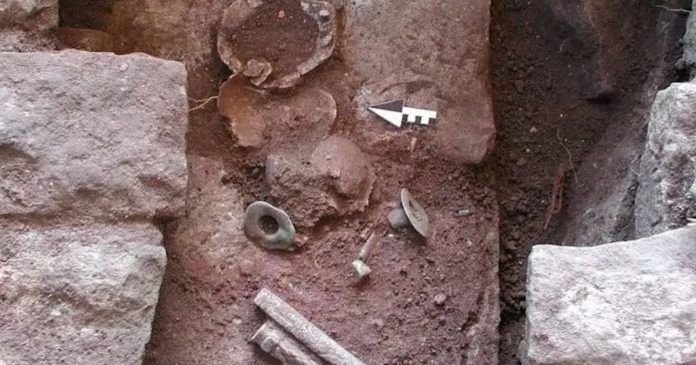New genetic research reveals the Maya collapse as transformation rather than extinction, with profound implications for understanding cultural resilience.
The Genomic Revolution in Maya Archaeology
Groundbreaking studies in Current Biology and Nature are reshaping our understanding of Maya civilization through ancient DNA. Researchers analyzed genomes from ritual burial sites in Honduras and Mexico. Their findings reveal remarkable evidence of genetic continuity, shifting population dynamics, and enduring cultural practices. These elements persisted despite one of history’s most dramatic societal transformations.
Copán’s Demographic Story: Decline Without Disappearance
Peak and Transformation at a Maya Crossroads
Copán, a UNESCO World Heritage site in Honduras, served as a vital political and cultural hub connecting Central and South America during the Classic Maya period (AD 250–900). Recent genomic analysis of seven individuals buried near Copán reveals:
Population Dynamics: Advanced modeling indicates Copán’s population peaked around AD 730 with approximately 19,000 inhabitants, likely supported by intensified maize agriculture. By AD 750—coinciding with the Classic Maya collapse—a significant decline began.
Genetic Continuity: Despite this decline, genomes show uninterrupted local ancestry from the Late Archaic period (≈3700–1000 BC) to present-day Maya populations, refuting theories of population replacement.
Elite Migration: Evidence of highland Mexican ancestry among Copán’s elite supports historical inscriptions describing founder K’inich Yax K’uk’ Mo’ (AD 426) as an outsider who established a 400-year dynasty.
“Our findings align with archaeological scenarios where populations decreased but didn’t vanish. Genetic continuity proves resilience.” — Shigeki Nakagome, Trinity College Dublin.
Ritual and Mythology at Chichén Itzá
Twins, Sacrifice, and Sacred Narratives
In a parallel study at Chichén Itzá—Mexico’s iconic Maya center—researchers analyzed 64 children from a chultún (ritual cistern) near the Sacred Cenote:
Exclusively Male Sacrifices: Genetic analysis revealed all individuals were male, countering earlier theories emphasizing female sacrifices. Remarkably, 25% were closely related, including two pairs of identical twins .
Mythological Connections: The twin sacrifices mirror the Hero Twins myth in the Popol Vuh, where twins undergo cycles of sacrifice and resurrection to defeat underworld gods. Their burial in a water-linked chultún (viewed as an underworld portal) reinforces this ritual-symbolic link.
Dietary Insights: Isotopic analysis showed related children shared similar diets, suggesting they were raised together before being selected for ritual purposes.
“This study turns lurid tales of sacrificed girls on their head. We see deep connections between ritual and sacred narratives of death and rebirth.” — Christina Warinner, Harvard University .
Colonial Trauma and Genetic Adaptation
Epidemics and Evolutionary Immunity
Comparing ancient genomes with those of modern Maya from Tixcacaltuyub revealed a dark legacy of colonial epidemics:
Selective Pressure: Modern Maya carry HLA gene variants (e.g., HLA-DR4) that enhance resistance to Salmonella enterica—the pathogen behind the 1545 cocoliztli epidemic that killed ≈90% of Indigenous populations.
Community Collaboration: Researchers worked with local Maya communities to contextualize findings, empowering Indigenous perspectives on history.
Why This Matters: Beyond the “Mysterious Collapse”
These studies collectively dismantle the myth of the Maya “disappearance”:
- Collapse as Reorganization: Political fragmentation did not equate to cultural extinction. Populations persisted, adapting to environmental and social pressures.
- Interregional Networks: Gene flow from Mexican highlands and Belize underscores the Maya world’s interconnectedness.
- Living Legacy: Today’s 7 million Maya people retain strong genetic ties to ancient Copán and Chichén Itzá inhabitants, proving unbroken biological and cultural continuity.
“As a Mayan researcher, preserving our historical memory is vital. Genomics helps reclaim our narrative.” — María Ermila Moo-Mezeta, Autonomous University of Yucatán.
Conclusion: A New Chapter in Maya History
These genomic insights reveal the Maya collapse not as a catastrophic end, but as a societal transformation marked by resilience. As populations navigated drought, political upheaval, and colonial violence, their genetic legacy endured—a testament to adaptation that continues to shape modern Maya identity. Future research promises further revelations as ancient DNA technologies illuminate the intricate relationships between biology, culture, and resilience in human history.
Sources:
- Murray et al., Current Biology (2025)
- Barquera et al., Nature (2024)
- Community engagement frameworks in archaeogenetics (Nature, 2024)

